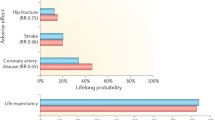Abstract
Hormone replacement therapy (HRT) is a collective term to include a variety of sex steroids, estrogens, and progestogens, given to postmenopausal women at various doses and administered through various routes. HRT is used for the relief of menopausal symptoms, with many women experiencing considerable improvement in their quality of life. It is also used for the prevention and treatment of osteoporosis, which is as effective as other available therapies. Other potential benefits of HRT are the prevention of cardiovascular disease and dementia. The main risks of HRT are an increased incidence of breast cancer and a transient increase in venous thromboembolism. The Women’s Health Initiative is the largest randomized clinical trial of HRT to date, and has demonstrated benefits and risks of one specific HRT regimen. Skeletal benefits have been confirmed in terms of fracture reduction, as has a small risk of breast cancer development. Further studies of other HRT regimens are urgently required to clarify the cardiovascular effects.
Similar content being viewed by others
References and Recommended Reading
Kuhn FE, Rackley CE: Coronary artery disease in women: risk factors, evaluation, treatment and prevention. Arch Intern Med 1993, 153:2626–2636.
Gordon T, Kannel WB, Hjortland MC, McNamara PM:Menopause and coronary heart disease. The Framingham Study. Ann Intern Med 1978, 89:157–161.
Gallagher JC, Baylink DJ, Freeman R, McClung M: Prevention of bone loss with tibolone in postmenopausal women: results of two randomized, double-blind, placebocontrolled, dose-finding studies. J Clin Endocrinol Metab 2001, 86:4717–4726. Two 2-year double-blind, randomized, placebo-controlled trials on the effects of various doses of tibolone on bone density in 770 postmenopausal women. Dose-dependent increases in bone density were observed with tibolone at both spine and hip.
Delmas PD, Ensrud KE, Adachi JD, et al.:Efficacy of raloxifene on vertebral fracture risk reduction in postmenopausal women with osteoporosis: four-year results from a randomized clinical trial. J Clin Endocrinol Metab 2002, 87:3609–3617. A 4-year double-blind, randomized, placebo-controlled trial (Multiple Outcomes of Raloxifene Evaluation) on the effects of two doses of raloxifene on new vertebral fractures in 7705 postmenopausal women. Raloxifene 60 mg produced a 36% reduction in new vertebral fractures, but no reduction in nonvertebral fractures.
Writing Group for the Women’s Health Initiative Investigators: Risks and benefits of estrogen plus progestin in healthy postmenopausal women. JAMA 2002, 288:321–333. A large, prospective, double-blind, randomized, placebo-controlled trial (WHI) of a specific continuous combined HRT regimen on various clinical outcomes in 16,608 postmenopausal women studied over 5.2 years. Among the benefits was a reduction in all osteoporotic fractures. However, there were increased risks in breast cancer incidence and a transient increase in coronary events. The conclusion was that risks outweighed benefits, but these risks and benefits were confined to less than 1% of the study population.
Lees B, Stevenson JC: The prevention of osteoporosis using sequential low-dose hormone replacement therapy with estradiol-17β and dydrogesterone. Osteoporos Int 2001, 12:251–258. A 2-year double-blind, randomized, placebo-controlled trial of low- and high-dose HRT effects on bone density in 579 postmenopausal women. Low-dose HRT was as effective in older women as high-dose HRT in younger women at spine and hip.
Cauley JA, Robbins J, Chen Z, et al.: Effects of estrogen plus progestin on risk of fracture and bone mineral density: the Women’s Health Initiative randomized trial. JAMA 2003, 290:1729–1738.
Stevenson JC: Cardiovascular effects of estrogens. J Steroid Biochem Mol Biol 2000, 74:387–393.
Stevenson JC: Metabolic effects of the menopause and oestrogen replacement. In Baillière’s Clinical Obstetrics and Gynaecology. Edited by Barlow DH. London: Ballière Tindall; 1996:449–467.
Stampfer MJ, Grodstein F: Role of hormone replacement in cardiovascular disease. In Treatment of the Postmenopausal Woman: Basic and Clinical Aspects. Edited by Lobo RA. New York: Raven Press Ltd.; 1994:223–233.
Hulley S, Grady D, Bush T, et al.: Randomized trial of estrogen plus progestin for secondary prevention of coronary heart disease in postmenopausal women. JAMA 1998, 280:605–613.
Manson JE, Hsia J, Johnson KC, et al.: Estrogen plus progestin and the risk of coronary heart disease. N Engl J Med 2003, 349:523–534.
Stevenson JC, Flather M, Collins P: Coronary heart disease in women. N Engl J Med 2000, 343:1891.
Henderson VW: Estrogen, cognition, and a woman’s risk of Alzheimer’s disease. Am J Med 1997, 103:11S-18S.
Grodstein F, Newcomb PA, Stampfer MJ: Postmenopausal hormone replacement therapy and the risk of colorectal cancer: a review and meta-analysis. Ann J Med 1999, 106:574–582.
Collaborative Group on Hormonal Factors in Breast Cancer: Breast cancer and HRT: collaborative reanalysis of data from 51 epidemiological studies of 52,705 women with breast cancer and 108,411 women without breast cancer. Lancet 1997, 350:1047–1059.
Willis DB, Calle EE, Miracle-McMahill L, et al.: Estrogen replacement therapy and risk of fatal breast cancer in a prospective cohort of postmenopausal women in the United States. Cancer Causes Control 1996, 7:449–457.
Million Women Study Collaborators: Breast cancer and hormone-replacement therapy in the Million Women Study. Lancet 2003, 362:419–427.
Bliss JM, Gray R: Breast cancer and hormone-replacement therapy: the Million Women Study. Lancet 2003, 362:1328–1330.
Scarabin P-Y, Oger E, Plu-Bureau G: Differential association of oral and transdermal oestrogen-replacement therapy with venous thromboembolism risk. Lancet 2003, 362:428–432. A case-control study of 155 postmenopausal women presenting with idiopathic venous thromboembolism. Users of oral HRT had an increased risk (odds ratio 3.5) of venous thromboembolism that was not seen with users of transdermal HRT (odds ratio 0.9).
Author information
Authors and Affiliations
Rights and permissions
About this article
Cite this article
Stevenson, J.C. Hormone replacement therapy: Review, update, and remaining questions after the women’s health initiative study. Curr Osteoporos Rep 2, 12–16 (2004). https://doi.org/10.1007/s11914-004-0009-z
Issue Date:
DOI: https://doi.org/10.1007/s11914-004-0009-z




